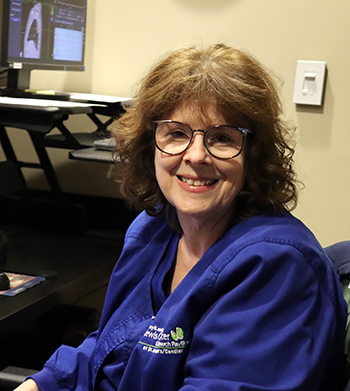What is radiation treatment planning?
Cancer
LCRP dosimetrist explains the process of how your radiation therapy starts before you even get there
There’s a team at the Nancy N. and J.C. Lewis Cancer & Research Pavilion that you may never meet. But if your cancer diagnosis requires radiation therapy, they are the ones planning your treatment. Their commitment is to ensure the highest quality of care.
Simply put, it’s called radiation treatment planning. Medically it’s known as dosimetry. It is the science of measuring or calculating radiation exposure. In a radiation oncology department, a dosimetrist is a medical professional who is certified to develop radiotherapy plans and to calculate doses of radiation delivered to cancer patients.
Radiation treatment planning involves radiation oncologists (you’ll meet them), dosimetrists, physicists and radiation therapists (you’ll meet them too).

Karol Wynn is the lead dosimetrist at the Lewis Cancer & Research Pavilion. She’s been in the oncology field for 36 years.
“Our job is to save everything that is around the tumor from radiation exposure while still giving the highest dose possible,” Wynn says.
The process
It starts with a CT scan called a simulation. Imagines will be taken in preparation for planning the treatment. Those images will help the dosimetry team tailor the treatment to each patient’s body and the specific machine that they will be treated on. At the LCRP, those machines include the TrueBeam and CyberKnife®. Both are state-of-the-art particle accelerators that deliver radiation.
A radiation therapist scans the area of the tumor to produce an image for the dosimetrist. The dosimetry team then brings the scan into a computer with software designed for radiation treatment planning, Wynn explains. The software will have the patient’s data in it as well as the machine’s characteristics; for example, how it moves around the patient to deliver radiation.
The radiation oncologists will add the tumor volume and prescribe the amount of radiation that they want the tumor to receive. The dosimetrists contour, or outline, the nearby internal structures. Then using the software, a treatment plan is designed to determine the machine’s movement, where the radiation will be delivered, and how much to that targeted area. Each plan is specifically crafted for every individual patient to deliver a high dose of radiation to the tumor while limiting exposure to nearby organs and tissues.
“It can be hard to put into layman’s terms what we do, but the most important thing is to know that there is a team mapping out and planning exactly where radiation will be delivered,” Wynn says. “It is the standard of care.”
Once your treatment plan is ready it is checked by numerous individuals. Our dosimetrists report directly to a physicist, who reviews each individual plan with separate measuring software to verify the plan. It also is reviewed by the radiation oncologists, as well as the radiation therapists.
“There are a lot of steps taken to ensure quality,” Wynn says.
The patient experience
If radiation treatment is needed, each patient can expect to go through a thorough planning process, Wynn says. Even patients with benign conditions that need radiation therapy will start treatment with a plan.
The CT simulation takes 30 minutes to an hour, Wynn says, depending on what molds or immobilization devices are needed. Then you let our team do the planning and your radiation oncologist will let you know when it’s time to start treatment.
Radiation treatment planning is done both in Savannah and at our Bluffton Campus.